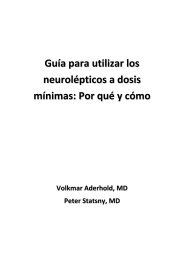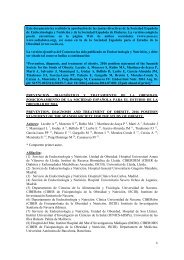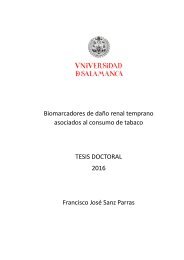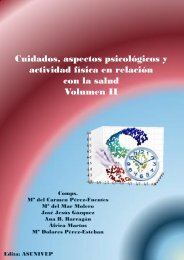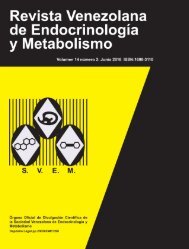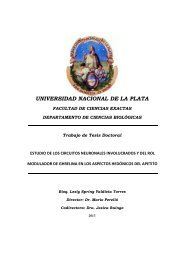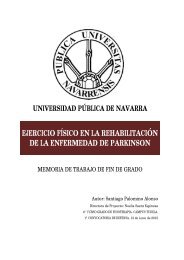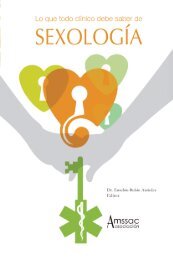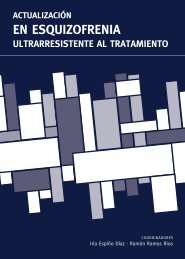Noviembre-Diciembre
156_v40n6(1)
156_v40n6(1)
Create successful ePaper yourself
Turn your PDF publications into a flip-book with our unique Google optimized e-Paper software.
Comparative study of preparation of hazardous drugs with different closed-system... Farm Hosp. 2016;40(6):496-503 - 501<br />
Table 1. Contamination, time and cost of the different modalities of closed-systems<br />
Contamination<br />
Modality<br />
1<br />
NO<br />
(0/40)<br />
Modality<br />
2<br />
NO<br />
(0/40)<br />
Modality<br />
3<br />
NO<br />
(0/40)<br />
Modality<br />
4<br />
NO<br />
(0/40)<br />
Modality<br />
5<br />
YES<br />
(2/40)<br />
Modality<br />
6<br />
NO<br />
(0/40)<br />
Modality<br />
7<br />
YES<br />
(5/40)<br />
Modality<br />
8<br />
NO<br />
(0/40)<br />
Cloth<br />
Gloves<br />
NO<br />
(0/40)<br />
NO<br />
(0/40)<br />
NO<br />
(0/40)<br />
NO<br />
(0/40)<br />
NO<br />
(0/40)<br />
NO<br />
(0/40)<br />
NO<br />
(0/40)<br />
NO<br />
(0/40)<br />
Critical Points<br />
YES<br />
(40/40)<br />
YES<br />
(40/40)<br />
YES<br />
(40/40)<br />
YES<br />
(40/40)<br />
YES<br />
(40/40)<br />
YES<br />
(40/40)<br />
YES<br />
(40/40)<br />
YES<br />
(40/40)<br />
Administration<br />
YES<br />
(40/40)<br />
YES<br />
(40/40)<br />
YES<br />
(40/40)<br />
YES<br />
(40/40)<br />
YES<br />
(40/40)<br />
YES<br />
(40/40)<br />
YES<br />
(40/40)<br />
YES<br />
(40/40)<br />
Mixture time<br />
77.0<br />
(70.8-83.0)<br />
55.5<br />
(50.0-59.0)<br />
69.0<br />
(66.0-71.8)<br />
54.5<br />
(48.0-57.8)<br />
56.0<br />
(54.0-58.0)<br />
43.0<br />
(40.0-47.8)<br />
58.5<br />
(55.2-62.0)<br />
41.0<br />
(40.0-43.0)<br />
Median 8.52 7.48 7.91 6.88 5.49 4.46 4.89 3.85<br />
See modalities 1-8 in Figure 1.<br />
IQR 25-75: 25-75 Interquartile range.<br />
critical point of the bags, the point of access through a<br />
CLAVE valve showed a mean difference of 0.03 cm higher<br />
than the Luer bag (p = 0.017). In the administration<br />
step, no differences were found among modalities with<br />
ChemoCLAVE ® vs modalities with Fleboflex ® with Luer<br />
connection. In all cases, after disconnection, both the<br />
CLAVE and the Robersite ® valves left a small drop on the<br />
cellulose paper (Table 1).<br />
An increase in the time of preparation was observed<br />
when the anchoring vs the supporting vial spike was<br />
used (p = 0.036). Mixtures prepared with the CLAVE valve<br />
needed 16 seconds more preparation time than with<br />
a Luer bag (p = 0.000).<br />
Modality 4 is the one that showed the highest effectiveness<br />
(supporting vial spike, connector and Luer bag).<br />
The cost of closed-systems for the preparation of HD is<br />
€ 6.88 when the valve system in combination with Luer<br />
solution is used, and € 7.91 when the ChemoCLAVE ®<br />
system is used (Table 1). Therefore, the introduction of<br />
solution bags allows a saving of € 1.03 per bag. An average<br />
of 3,161 treatments with infusion bags are performed<br />
monthly in our hospital, the economic impact of<br />
closed-systems is about € 300,000 per year. The introduction<br />
of Luer bags combined with the valve system of<br />
ICU Medical System could allow an annual saving of €<br />
39,069.<br />
Discussion<br />
The evaluation of closed-systems in relation to contamination<br />
decrease has not yet been standardized<br />
and there are no recommendations about which closed-system<br />
to use 7 . Most studies attempting to show<br />
less environmental contamination with closed-systems<br />
are studies of surface contamination, with sampling techniques<br />
that allow evaluating residual contamination<br />
of cytostatic drugs. Other studies have used surrogate<br />
markers such as fluorescein, titanium tetrachloride and<br />
radioactive technetium 18 . NIOSH has recently proposed<br />
a protocol to determine the effectiveness of the closed<br />
containment systems to retain vapors 22 . Despite doubts<br />
about safety of filter-retention devices for drugs that<br />
may be vaporous 4 , their use in our country is common.<br />
Our study has been performed with fluorescein, a<br />
marker that is not considered as particularly sensitive,<br />
but that is useful to detect drops and splashes during<br />
handling. In addition, it is a simple and inexpensive method<br />
and fluorescein is not harmful for the handler 18 .<br />
The UV source used in this study may have less sensitivity<br />
to detect spillages in comparison with other more<br />
intensive, and hence more expensive, UV sources on the<br />
market. This may be a limitation of the study.<br />
One of our main findings is that the Spiros ® connector<br />
of syringes is critical in considering the system as completely<br />
closed. Although the number of splashes was low<br />
even when this connector was not used, it is necessary<br />
to become aware of the importance of working in the<br />
optimum conditions to minimize the risk of exposure by<br />
reaching the lowest technically possible contamination<br />
level.<br />
It has not been possible to show a higher theoretical<br />
safety of anchoring spikes because there has not been<br />
any accidental movement of the supporting vial spike<br />
resulting in spilling or splashes.<br />
Concerning the use of Fleboflex ® solutions during<br />
the preparation of the mixtures vs the bag spike with<br />
CLAVE valve, both methods have been equally safe. The<br />
risk of splashes did not increase. Additionally, its use has




